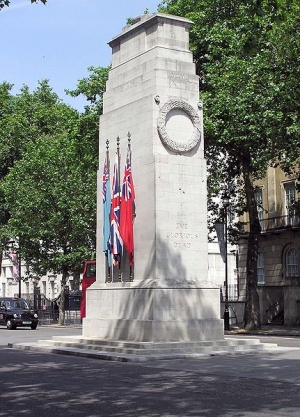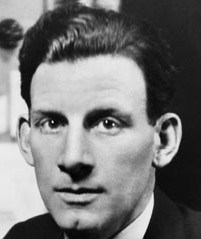The Cenotaph
 | |
| Type | memorial |
| Locations | Whitehall, London |
The Cenotaph is a war memorial situated on Whitehall in London. It began as a temporary structure erected for a peace parade following the end of the First World War but following an outpouring of national sentiment it was replaced in 1920 by a permanent structure and designated the United Kingdom's primary national war memorial.
A National Service of Remembrance is held at the site on Remembrance Sunday, the closest Sunday to 11 November (Armistice Day) each year. The service commemorates UK military war deaths only. It specifically excludes the civilian victims of war.
Contents
Origins and purpose
The word "Cenotaph" is of Greek origin. It's root meaning is loosely defined as "Empty Tomb". The UK Cenotaph is a national memorial dedicated military personnel who died whilst serving in the "British Empire" (later "Commonwealth") armed forces in wars and other conflicts since World War I. The focus of remembrance Sunday on military deaths only is controversial, especially so since it necessarily involves military parades which are all to easily interpreted as conflating remembrance with military glorification. There are those who feel that sack-cloth and ashes would be more appropriate attire than the bemedaled, dress-uniform splendour of its Royal and military General-Staff attendees.
The following by WWI decorated soldier and poet Siegfried (Mad Jack) Sassoon [1] is a moving encapsulation of a nagging and vaguely unsettling suspicion - in those who genuinely reflect on these things - that the overt military form of Remembrance Sunday is motivated by something other than genuine grief at the realities of war.
At the Cenotaph
I saw the Prince of Darkness, with his Staff,
Standing bare-headed by the Cenotaph.
Unostentatious and respectful, there
He stood, and offered up the following prayer:
Make them forget, O Lord, what this Memorial
Means; their discredited ideas revive;
Breed new belief that War is purgatorial
Proof of the pride and power of being alive;
Men’s biologic urge to readjust
The Map of Europe, Lord of Hosts, increase;
Lift up their hearts in large destructive lust;
And crown their heads with blind vindictive Peace.
The Prince of Darkness to the Cenotaph
Bowed. As he walked away I heard him laugh.
See Also
External Links
Further information about the history, design, construction etc of the Cenotaph, and the nature of Remembrance Sunday at the following links:
- The The Cenotaph, Whitehall - Wikipedia page
- The Cenotaph: Original Design for the Structure in Whitehall
- Hiding behind the Cenotaph, Cameron will seek to re-write history - Open Democracy 12 November 2013
- The Cenotaph 2013 - Veterans for Peace
- Remembrance day - but what to remember? - The peace Pledge Union
Related Documents
| Title | Type | Publication date | Author(s) | Description |
|---|---|---|---|---|
| Document:I will wear a poppy for the last time | article | 8 November 2013 | Harry Smith | A WW2 veteran airs his disillusionment with the way in which the establishment's cynical use of remembrance day to promote the official narrative of all the US/UK/NATO military escapades as being purely altruistically motivated. |
| Document:Remembrance Day and the truths that dare not speak their name | blog post | 8 November 2018 | John Wight | If Remembrance Day imparts a message worthy of our collective intelligence it is that war should be made a crime, with those who instigate it punished as criminals. In the last analysis it does not determine who is right only who is left. We have met the enemy and he is us. End. |
References
- ↑ Siegfried Sassoon - Spartacus Educational
